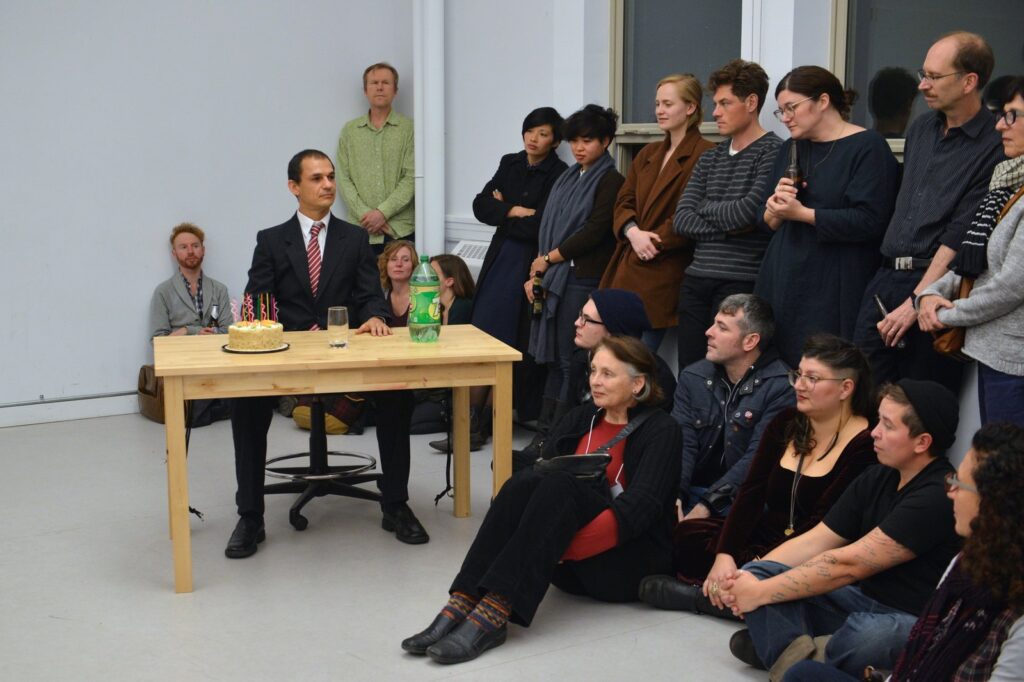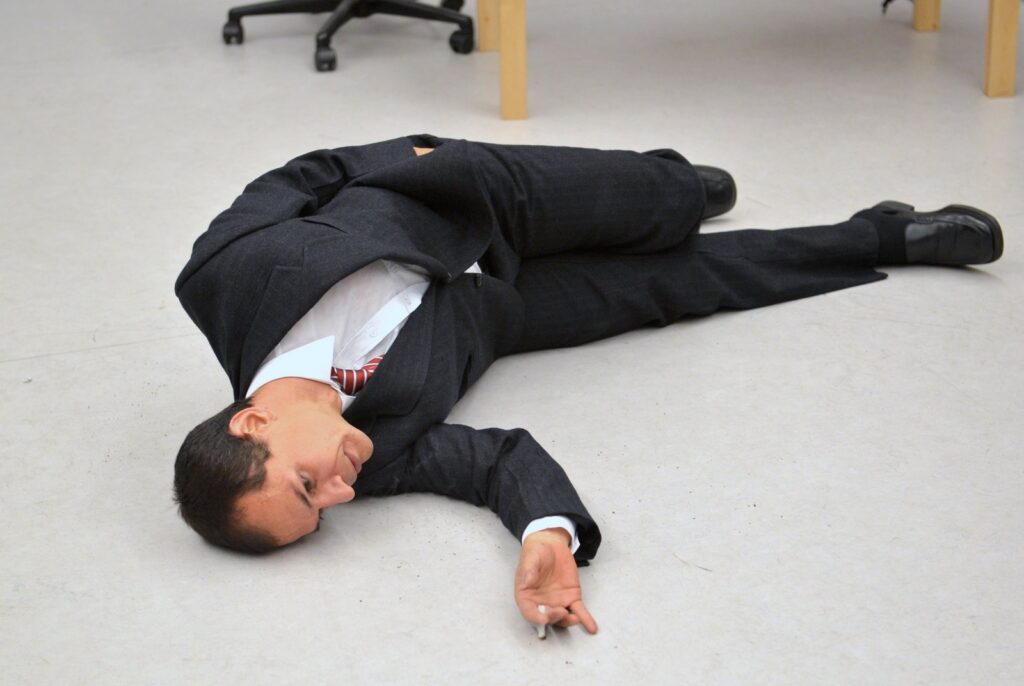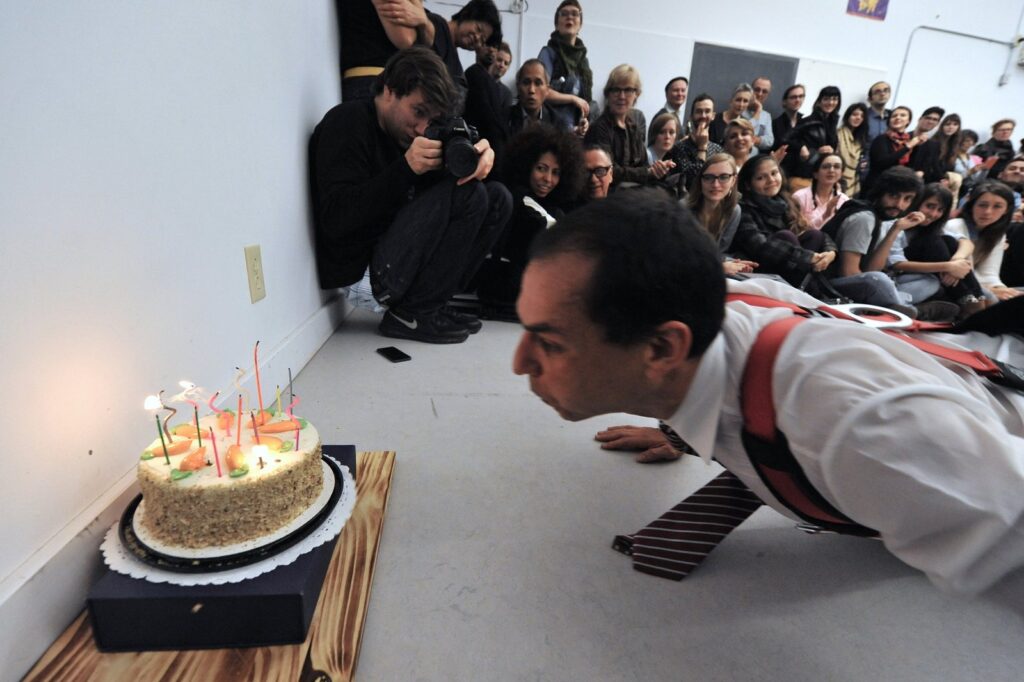By Jenn Snider

Eduardo Oramas is already seated when we arrive. Settled and straight-backed at his desk, the artist is dressed in a dark suit with a silver-striped red tie, and he gazes at the door through which the large festival crowd comes. On the table, he has some fixings for a bit of a celebration. Felicitaciones / Congratulations is the name of this art-game, and so far the rules are unclear. There is a cake covered in candles, a drinking glass, and a 2-litre bottle of 7-Up. Around the room are other conditions that provide clues—a dozen balloons tied in a bunch at ceiling height, a pin-the-tail on the donkey poster taped high on the wall, and a climbing harness hanging from a hook.
Oramas’ face, mouth in a slight frown, registers as unimpressed. His hands, planted palm down on the tabletop, are shoulder width apart in that way that suggests control. Feet in black leather shoes are spread wide apart. Oramas is unmoving, and as such he is commanding. Oramas is watching, and he’s waiting for us all to sit down.
The tremors build slowly. This stern figure, it seems, is not as infallible as he first appears. When his right foot begins to tap, this tap-tapping grows more rhythmic. When the left foot joins, for a moment, he’s Fred Astaire. Then it’s the hands that twitch and flail, now the legs, and his arms too. He’s no longer dancing. There is no music, and this is no earthquake. Fully convulsing, Oramas’ body rocks the chair which has rolled away from the table. Shaking, rocking and horribly juddering the previously stoically firm man in the suit has aggressively transformed to a erratic shuddering body, with hanging head and drooping lips—it’s the kind of movement we might recognize as a seizure.
In his practice, Oramas creates endurance performances that focus on relationships between the body and its environment, specifically those that happen within the city. Incorporating improvisation and the interdisciplinary, Oramas is interested in how we can collectively build meaning and exceed what we know about our potentials.

With a final jerk, Oramas collapses to the floor and is still. Breathing heavily, he lies there and slowly his heaving relents. Rising, he lights a cigarette from a mashed pack in his pocket, and begins again to play with our collective senses and sets of expectations.
He falls, this time gracefully with the cigarette in hand and his other stuffed in his pocket. With a sudden shift to a one-armed push-up, Oramas gives us a decent Jack Palance impression. Pinched between two fingers, Oramas’ cigarette burns. Lurching, he tries to grab a quick drag without losing his balance. Missing, his palm slams down in time to save the stance, smoke wafted into his face. He tries again but it’s no good. Falling often, he tries over and over again. Supporting shaking arms and legs, his hand won’t reach his lips. It’s an apparently impossible undertaking today, and this is maybe how we discover the most important rule of Oramas’ celebratory game: challenging limits.

Pulling a bundle of string from his pocket, tied on one end with a red bow, Oramas gestures to the crowd. He parts them as though they were the proverbial sea. He needs them to make way. He’s got to try, and fail, to pin this tail on the donkey, twelve-feet up on the wall.
Next, he removes his jacket and shoes, socks too. Strapping on the harness, he takes a lighter from his pocket. It’s time to light the candles and get the party started. Placing the cake with burning candles at the opposite end of the room, Oramas returns to the desk and leashes himself to the wall with elastic restraints. He’s going to try and blow out those candles. He’s going to try very, very hard. We’re all going to cheer, chant and sing to encourage him. He’s going to fail here too, but that’s maybe just chance. Or maybe, again, it’s the point.

Human endeavors are perhaps equal parts skill as gumption. Oramas has enough of both, but he also has limits. “It’s because you smoked,” someone obnoxiously offers from the crowd. Oramas smiles. Our bodies all fail us sometimes.
He’ll drink the two litres of pop, if the straps on his wrists will allow the glass to reach his mouth. Then he’ll sit and sweat in between sips, and we’ll hear his exhaustion and remember it when next he’s jumping high into the air to pop balloons one by one.
It’s been a grueling hour of games mixed with a salty sting, and when that last balloon pops and the room erupts, Oramas joins in on the cheers and applause. He watches us and we watch him. He is clearly spent, and it seems that his face is drawn a bit tight as it was before. Even his clapping feels a bit insincere. It could mean the artist is again in control, or it could be he’s too tired to smile. It’s hard to tell. The spectacle of it all undercut the simplicity of compassion. I was rooting for him to ‘win’, but maybe you weren’t. Maybe he can tell.
